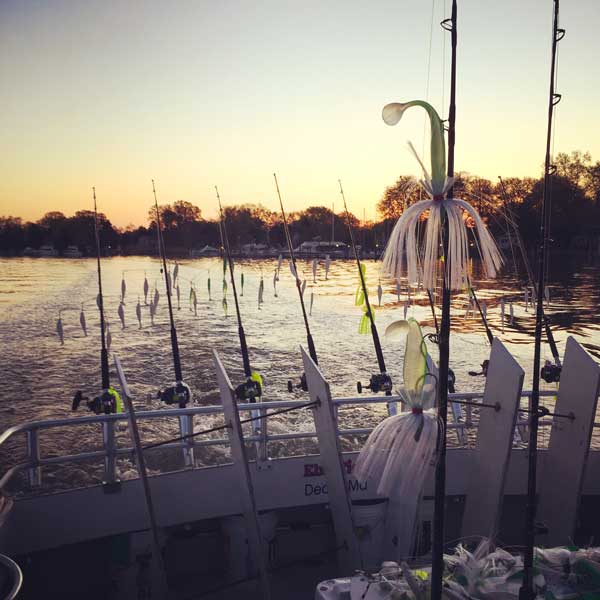Just pulling lures behind your boat may catch a fish or two, but trolling with the correct lures at the proper speed and the right depth and distance from the stern for the target species will put more fish in the box.

Trolling Tackle
While you can troll with anything from Penn Internationals on custom rods with roller guides to hand lines, I find simple conventional reels on sturdy rods do an adequate job. When I had my charter business, I used Penn Jigmaster reels on Shakespeare Sturdy Stick rods. They served me well for 15 years and are still in good shape today.
Spinning reels were not made for trolling. They were made for casting light weights and ease of operation for folks just getting into fishing. No doubt they expanded our sport and made it what it is today, but they just don’t work well in a trolling situation.
The spool of a spinning reel does turn against the drag when the line leaves the reel after a fish hits the lure. Unfortunately, it does not come directly off as it does on a conventional reel. The line has to pass through the bail roller, and this will result in line twist and wear as well as added drag. With a conventional reel the spool turns against the drag as the line is taken by the fish after a strike. No line twist and no added drag.
Rockfish
First, let me say I am not a fan of trailer boats trying to pull planer boards. Go ahead and do it if you want, but trying to handle that many lines from an eight-foot beam boat while keeping away from all the other boats doing the same thing makes for a very busy captain and crew.
The majority of rockfish are caught on or close to the bottom, so that’s where your lures should be working. Wire line is a big help in achieving this, but mono line can be made to work with the addition of heavy weights or by using large MOJOs.
When trolling for rockfish, you really can’t go too slowly. Once you set your speed, begin by dropping the lure or lures back until you feel them hit bottom. Do this two more times before placing the rod in a holder and checking to be sure the drag is properly set. The drag should be firm, but not so tight that the fish can’t take line; one third the pound test of the line is the standard. If you are using wire or braid, this setting is critical because these lines have no stretch, and the force of a big fish can snap your rod.
Bluefish and Spanish Mackerel
Since big blues have not entered the Chesapeake Bay in years, we will concentrate on the smaller ones that travel up the Bay in the summer and are often found mixed in with Spanish mackerel.
My personal favorite lure for both species is a Huntington Drone size 0 spoon. I fish it behind either a one or two-ounce trolling sinker or a small Huntington planer. In either case I tie a 30-foot length of 15-pound test High Seas mono leader from the sinker or planer to the spoon. A ball-bearing snap swivel is connected between the leader and the sinker or planer to reduce the line twist. Make no mistake, there will still be line twist, and at the end of the day the leaders will end up in the trash and new ones will have to be tied. I tie up at least six rigs, so I can quickly replace lost or hopelessly twisted leaders during the trip.
I will run two planer lines off the stern and two sinker lines from my outriggers. You must be very cautious not to let these lines mate or you will have the spawn from Hell. Should this occur, the only remedy is to cut everything off and re-rig.
This is strictly meat fishing. The heavy tackle required to handle a planer is no match for small blues or Spanish mackerel. Even the outrigger lines will be dampened by the sinkers.
Trolling speed is usually between five to six knots. You must take into consideration the speed of the current as it adds or subtracts the speed of the water flowing past the lure. If your SONAR has a speed reading, that is usually the speed of the water going past the boat and your lures. Your GPS speed is how fast you are going over the bottom.
By Eric Burnley